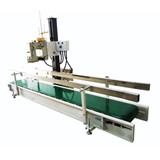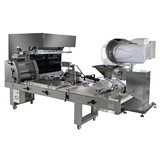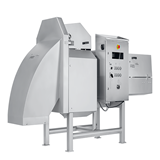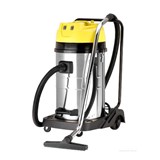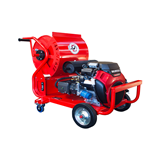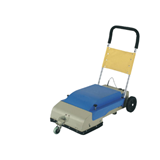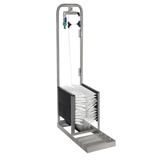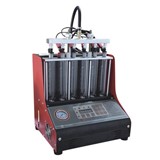Department of the Environment and Heritage
Background
Norske Skog Paper Mills (Australia) Ltd (formerly Australian Newsprint Mills (ANM)) operates an integrated pulp and paper mill at Albury, New South Wales, which was established in 1981. The facility currently manufactures approximately 210,000 tonnes of newsprint annually using thermomechanical and recycled fibre (RCF) pulping processes. This represents around 30 percent of Australia's newsprint requirements. Norske Skog is Australia's only domestic manufacturer of newsprint and also operates a newsprint mill at Boyer, near Hobart, Tasmania.
The Process
Waste paper
Prior to the establishment of its Albury recycled fibre plant in 1993, the company was not involved in waste paper recycling. Until that time, much of the waste paper generated in Australia ended up in landfills. The recycling project significantly raised the Australian old newsprint recovery rate from 37 percent of annual consumption in 1991 to 60 percent in 1996. Australia currently recycles 70% of the newsprint consumed domestically.
Waste water
While the Albury Mill has always been a low consumer of water by world paper industry standards, it nonetheless draws all its water requirements from the Murray River and is the largest industrial user on the river, taking 4,490 ML annually for paper manufacture.
Solid waste
The major solid waste product produced by the mill is a biosolid derived from two main sources: unincorporated wood fibre and effluent treatment activated sludge; and unincorporated recycled fibre, waste ink and magazine fillers.
One dry tonne of water treatment biosolid contains the nutritional equivalent of 1.6 kg of double superphosphate and 3.5 kg of urea. Recycled fibre biosolids provide the equivalent of approximately 80kg of lime per dry tonne. Traditionally, these biosolids have been landfilled.
Cleaner Production Initiative
In the mid 1990's, the Albury mill made a number of major modifications to its newsprint manufacturing process. These modifications have not only altered the quality and type of newsprint produced but have also had an impact on the waste products generated by the plant.
Waste paper recycling
In 1993, the mill constructed Stage 1 of its waste paper recycling plant. The plant allowed the company to produce newsprint with a 25 percent recycled fibre component. In 1995, Stage 2 commenced operations, more than doubling plant capacity. The construction cost of both stages amounted to $100 million and raised the recycled component of Albury newsprint to 40 percent. De-inked recycled pulp is also transported to the company's Boyer Mill in Tasmania allowing it to produce a newsprint sheet with up to 20% recycled fibre content.
The newsprint manufacturing process at Albury now requires the purchase of over 48,000 tonnes of old magazine and 112,000 tonnes of old newsprint annually. Wastepaper is sourced from eastern Australian cities and also from many rural areas. Wastepaper is transported to the mill on trucks used for the delivery of finished product, thus improving the efficiency of both newsprint distribution and wastepaper delivery.
Management of waste water has always been an important issue at Albury. Water is used for two main purposes - paper making and cooling.
Cooling water (around 4 ML per day) is used to cool machinery e.g. hydraulic oil units, refiners and motors. It is kept separate from other water sources and uses, and remains uncontaminated by the paper making process. This water does not require treatment (other than when first entering the mill) but is monitored for contamination. After being recycled several times, it is returned to the Murray River in accordance with EPA licence conditions. Return water is utilised by a race course.
Paper making water (around 8 ML per day) is added to wood and recycled pulp until a dilute solution of wood fibre (1 percent solids) is created. This pulp solution is sprayed onto a rotating plastic mesh fabric, where water is then removed leaving behind a matted web of fibres - paper.
The water used in this process becomes contaminated with wood fibres not incorporated in the paper, with chemical residues from the raw materials used and from chemicals added to control pulp pH and brightness. The water is treated to recover wood fibres and remove contaminants before being reused in the pulping process. Excess water and unrecoverable fibre is treated in a tertiary water treatment process.
After treatment, the waste water is used to irrigate a 350 hectare plantation (largely consisting of radiata pine) established in 1993 on company owned land adjacent to the paper mill.
Solid waste
Prior to trials conducted by the mill in 1992, experimentation with the agricultural reuse of paper mill waste in Australia had been minimal. The trials on both pasture and croplands close to the mill demonstrated that beneficial agronomic effects could be obtained under a range of conditions and that farmer acceptance in using biosolids was high.
Norske Skog has now developed a full scale land spreading operation on privately owned land within 25 km radius of the mill. Careful selection and classification of potential land spreading sites and soil types has meant that the operation can continue well into the winter period with minimal impact on soils, farm tracks etc.
In addition to the biosolids, a solid waste in the form of bark, sawdust and tree branch material is produced during timber processing operations at the mill. This material is used to fire boilers in the generation of steam for the paper making process. Approximately 15,000 tonnes of oven-dried bark are produced annually. 10 percent of this is sold for landscaping and horticultural purposes. The remainder is burnt and provides an alternative to the use of gas in the steam generation process. This gas substitution may have a value of up to $0.5 million per annum and may meet up to 20 percent of the mill's steam generation requirements.
Advantages of the Process
Waste paper
Recycling of waste paper at Albury has not only helped overcome the growing problem of paper waste, but enabled the company to provide better quality newsprint, increase marketing opportunities and reduce pulp processing costs.
The financial benefits from waste paper recycling are relatively small at the present time. Indeed the cost of producing thermomechanical pulp from pine thinnings is often less than the cost of purchasing, transporting and reprocessing recycled fibre. The main advantages to the company in using recycled fibre production are improved paper quality and maintenance of market share.
Waste water
The Albury Mill has always been a low consumer of water by paper industry standards. This has been achieved through original mill design and improvements to operations, which allow for the recycling of water used in the papermaking process. Current water usage at Norske Skog Albury is around 12kL per tonne of paper, compared with 100kL per tonne for older mills and approximately 10kL per tonne for more modern mills.
An important result of the waste water initiatives is that the Albury Mill has ceased routine river discharge of treated waste water into the Murray River. Water within the mill is recycled up to 18 times before it is released for treatment. Further internal recycling may be possible in the future, but is currently limited by the effects on treated process water quality (notably dissolved salts) and hence on the effluent's suitability for irrigation.
Harvesting of timber grown in the irrigated plantation has commenced and the timber has proven suitable for papermaking. A significant commercial pulpwood resource is now located immediately adjacent to the mill.
The financial benefits of wastewater reuse at the Albury mill are difficult to quantify. The annual operating cost of wastewater reuse is estimated at more than $300,000. Under current regulatory philosophies and licensing arrangements, the mill would not have been able to recycle wastepaper and continue to discharge wastewater into the river. Wastewater recycling has therefore enabled wastepaper recycling operations to be introduced and maintained at Albury.
The financial returns from the irrigated plantation will cover some of its annual operating costs. However the $10 million establishment cost of the project had to be funded from paper making operations, resulting in reduced profits for the establishment and loan repayment period.
Incentive
Waste paper recycling
Recycled fibre (RCF) was adopted as a source of newsprint for a number of reasons:
Government and community pressure - in being the only domestic manufacturer of newsprint, ANM (now Norske Skog) was subject to significant government and community pressure concerned with wise use of resources, a growing volume of wastepaper and declining landfill space. As a manufacturer of this product, the company was seen by many to have a responsibility for its disposal or reuse. The company also accepted this responsibility.
Better newsprint - by incorporating recycled magazine pulp (magazine pulp is typically produced by chemical means) into the newsprint furnish, the paper produced by the Company has improved in quality, notably in tensile strength and caliper (sheet thickness).
Better marketing opportunities - by having a significant recycled component in its product, the company has gained improved marketing opportunities and a greater customer acceptance of the product.
Reductions in pulp processing costs - the power consumption associated with repulping recycled fibre is about 20 percent that of virgin pulp manufacture. The Albury Mill has lowered its energy use and greenhouse gas emissions substantially as a result of its introduction.
Waste water reuse
The wastewater reuse scheme was adopted due to community concerns about river water quality; government and regulatory pressure to phase out in-river discharges; and the potential to grow a significant pulpwood resource on land adjacent to the mill.
Solid waste reuse
The land spreading of biosolids was chosen as the preferred method of reuse because the material proved useful as an agricultural soil conditioner, providing organic matter, nutrients and calcium as a lime substitute. Landspreading conserves current landfill space and avoids the need to develop a new landfill in the future.
The use of wood waste in the production of steam means that it is possible to reduce gas consumption and greenhouse gas emissions.
Barriers
The development and operation of waste reuse activities at the Albury Mill suggests that waste issues in large scale manufacturing operations may be difficult, expensive and complex. Solutions to waste problems often involve years of research and planning. The most successful solutions to waste problems are those that view waste products as "wasted" products. The Albury experience also suggests that there is always room for improvement in any waste reuse scheme.
The main barriers included regulatory and technological issues. Recycling and wastewater reuse required an Environmental Impact Statement (EIS), which in 1993 cost over $1 million to prepare and guide through the various stages to approval.
The installation of the recycled fibre plant in 1993 involved significant technical risk. RCF technology has advanced rapidly in recent years.
Knowledge about effluent irrigated plantations has also advanced considerably in recent years. The initiative at Albury virtually doubled the area of irrigated plantation in Australia. The technology needed and the size of the project meant that there were no benchmarks to compare against or build upon.
Wastewater reuse continues to involve a level of uncertainty and technical risk in regard to the long term potential impacts on soil and groundwater. Because of this an intensive monitoring programme has been established in order to test for and avoid any negative long term impacts.
Further Developments
Reduced use of raw materials and energy in the manufacture of paper
When the mill was established in 1980 it initially manufactured 48.8 gsm (grams per square metre) newsprint. Paper grammage refers to the weight of a square metre of the paper sheet. From a resource use perspective, the lower the grammage the better.
In 1995, the mill commenced the manufacture of 45 gsm newsprint and in 1998 successfully produced 42 gsm newsprint.
The introduction of recycled fibre into the newsprint sheet (averaging 40% but on occasions up to 55% recycled fibre content) has facilitated this reduction in grammage by providing strong, high quality fibres and clay fillers (from magazines). These allow the paper strength and optical properties to be maintained despite the lower grammage.
Around one quarter of the Albury mill-s annual production is now 42 gsm paper and the remainder is 45 gsm.
Newsprint manufactured at the Albury mill can now weigh up to 14% less than it did 20 years ago. This means that fewer resources and less energy are used to produce the same printable area of paper.
Lower grammage paper also means that more newspapers can be printed from a single reel of paper. This reduces the volume of paper transported to customers, providing fuel and other savings. It also reduces the amount of paper that needs to be recycled later.
Reduction of odour emissions and chemical and water usage
By implementing a series of changes to its operations over recent years, Norske Skog has significantly reduced odour emissions from their waste water treatment plant and also reduced chemical usage.
Upstream manufacturing processes and their potential impacts on odour were analysed in the adoption of an alternative process for pulp brightening. The new process uses less chemicals to brighten the pulp. Through a better understanding of the factors generating odour in the effluent treatment plant, the company also discovered it no longer needed to add chemicals to mask or reduce odour. Redesigning the effluent equalisation basin and installing more appropriate aeration equipment also reduced electricity consumption and odour potential.
In addition to reducing odour, these changes have resulted in the following benefits:
reduced chemical usage, generating savings in chemical use and handling
more stable and effective pulp processing conditions
more stable flow conditions (and hence more effective treatment) within the wastewater treatment plant
better quality wastewater for reuse on the company's 350 hectare pine plantation
fewer occupational health and safety issues.

